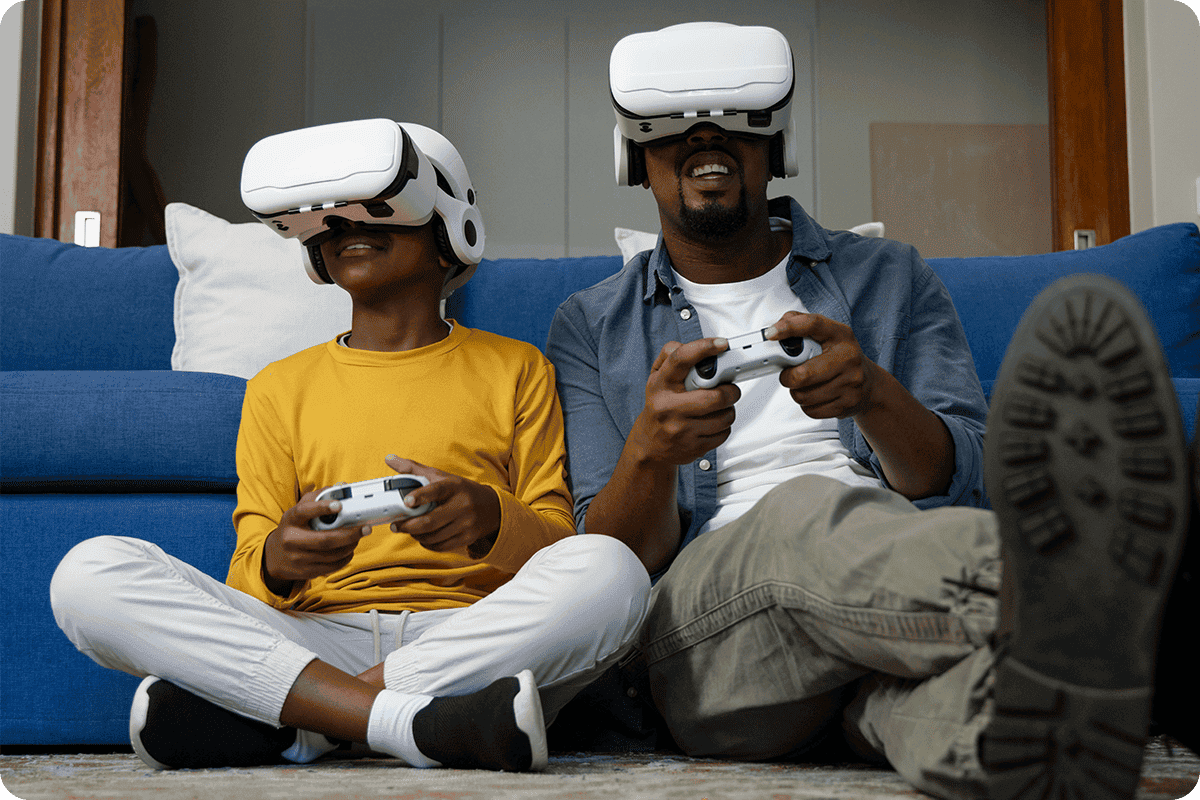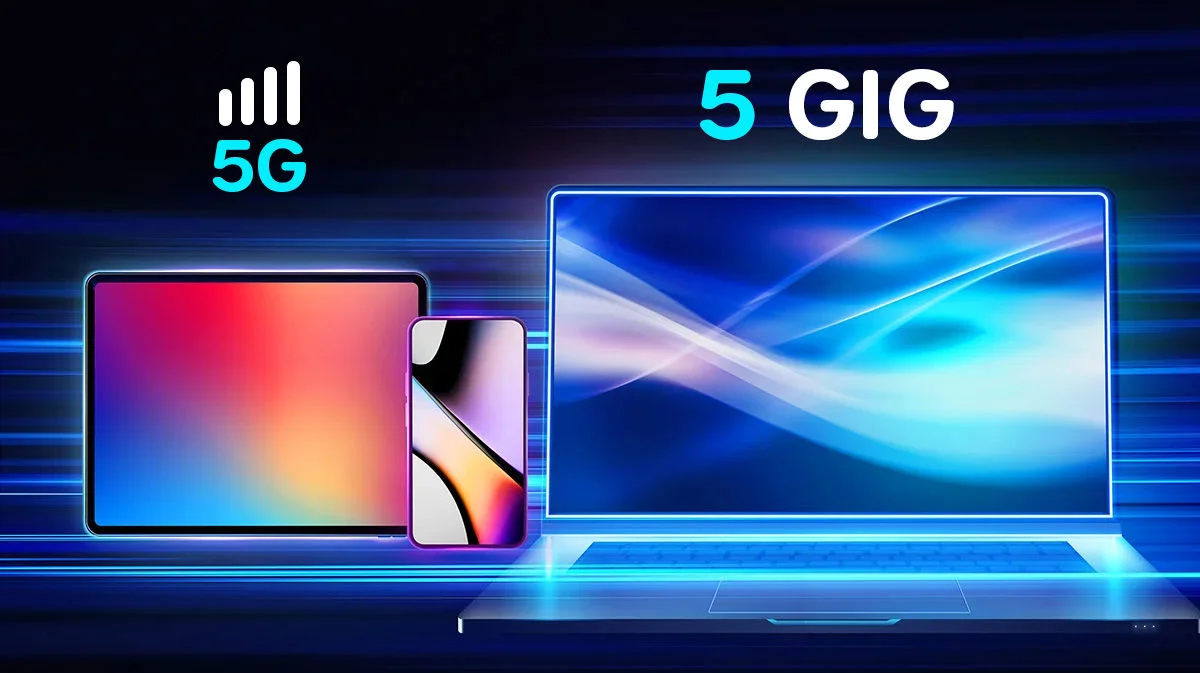Virtual Reality Explained: Benefits, Challenges & Future Trends
By: Vincent Totino
Read Time: 13 min.
July 17, 2025
Virtual reality allows people to experience the world in ways they never could before. Ever wondered what it would be like to stand on top of a waterfall, fly with the birds, or visit Paris for a couple of hours? VR technology gives you the ability to go on adventures and travel around the world—even outer space—without leaving the comfort of your home.
Although this may seem futuristic or inaccessible, there’s a solid chance virtual reality is in your life already. For instance, many video games allow players to engage with virtual worlds and characters, using VR technology to make the experience feel more real.
In this article, we will discuss what virtual reality is, the pros and cons of virtual reality technology, its limitations, and what the future holds.

What is Virtual Reality?
Virtual reality (VR) refers to a computer-generated simulation or recreation of a three-dimensional (3D) environment that users can interact with using specialized hardware and software, such as a VR headset or helmet. This technology creates an immersive illusion that the user is somewhere else.
There are three types of virtual reality: non-immersive VR, semi-immersive VR, and fully-immersive VR. Each one offers varying levels of immersion and interaction, catering to different use cases and budget considerations.
Here’s an overview of each:
Non-immersive VR
Also known as desktop or 3D VR, non-immersive VR is the most basic form of virtual reality. In this type, users experience virtual environments through a computer screen or a handheld device, such as a smartphone or tablet. This means that users can view the virtual world on a screen and observe their real-world surroundings simultaneously.
Some examples of non-immersive VR include virtual tours, 360-degree videos, and flight or driving simulators.
Semi-immersive VR
Semi-immersive VR offers a more immersive experience than non-immersive VR but does not fully engulf users in a virtual environment. In this type, you typically wear a head-mounted display (HMD) that covers only part of your field of view.
The HMD may include motion tracking, allowing you to look around the virtual space by moving your head. However, your body movements are not fully tracked, which can limit the level of immersion.
Applications of semi-immersive VR include gaming experiences and training applications where you can interact with virtual environments through your head movements.
Fully-immersive VR
The third type of VR—fully immersive—provides the highest level of immersion and presence, offering a realistic and seamless virtual experience. For this type, you can wear special head-mounted displays (HMDs) or VR goggles that cover your eyes and ears.
These allow for 360-degree view and sound, which creates a real sense of presence within the virtual world. The displays also typically have high-resolution screens for each eye that can help enhance depth perception.
With this gear, you can interact with the virtual environment using both head and body movements. Some fully-immersive VR setups include additional accessories, such as motion controllers or haptic feedback devices, to further enhance the experience.
Examples of fully-immersive VR include high-end gaming experiences, virtual simulations for medical training or pilot training, and advanced architectural visualization tools that allow users to walk through virtual buildings.
What is Virtual Reality? Understanding the Meaning of VR
Difference Between AR and VR
While augmented reality (AR) often comes up in conversations about VR, there are notable differences between the two. The underlying technology is, in fact, closely intertwined, but AR is basically the cousin of virtual reality.
A defining characteristic of AR is that it still has one foot in the real world. The technology simulates artificial objects within reality, meaning objects and images are placed in the real world. Virtual reality, however, doesn’t feature any existing territory and instead happens within an entirely artificial environment.
One of the most well-known examples of AR is the game Pokémon Go. In it, you can walk around your neighborhood while virtually catching Pokémon.
It’s worth noting that although VR and AR are different, they can be used together. For example, both are fields of the Metaverse, which you can learn more about here.
Benefits of Virtual Reality
VR technology, when used for good purposes, can offer endless possibilities, opportunities, and excitement. It can benefit various fields and industries, such as education, medicine, architecture, and entertainment. The technology can also simulate senses such as hearing, touch, and even smell.
Below are some of the main benefits of virtual reality.VR technology, when used for good purposes, can offer endless possibilities, opportunities, and excitement. It can benefit various fields and industries, such as education, medicine, architecture, and entertainment. The technology can also simulate senses such as hearing, touch, and even smell.
Below are some of the main benefits of virtual reality.
VR technology, when used for good purposes, can offer endless possibilities, opportunities, and excitement. It can benefit various fields and industries, such as education, medicine, architecture, and entertainment. The technology can also simulate senses such as hearing, touch, and even smell.
Below are some of the main benefits of virtual reality.
Enhanced learning
The VR world enables interactive and experiential learning, which makes education more engaging and enjoyable. Complex subjects can be simplified and presented in a visually stimulating manner, which leads to better retention and understanding.
Plus, it’s possible to conduct activities virtually; teachers can lead virtual excursions for educational purposes. Many schools are already taking advantage of these capabilities to enrich lesson plans.
Entertainment and gaming
Virtual reality has revolutionized the world of gaming. VR gaming allows people to place themselves in a game as if they were one of the characters. It’s an entirely new level of immersion and interaction.
With VR, players can fully engage in a game's world, leading to enhanced enjoyment and a more memorable gaming experience.
Training and education
VR has proven to be highly effective for training in various industries, such as healthcare, aviation, military, and manufacturing. It allows trainees to practice and simulate real-life scenarios in a safe and controlled environment, improving their skills and decision-making abilities.
During the COVID-19 pandemic, the healthcare industry used VR to train workers in infection control protocols and personal protective equipment (PPE) use.VR has proven to be highly effective for training in various industries, such as healthcare, aviation, military, and manufacturing. It allows trainees to practice and simulate real-life scenarios in a safe and controlled environment, improving their skills and decision-making abilities. During the COVID-19 pandemic, the healthcare industry used VR to train workers in infection control protocols and personal protective equipment (PPE) use.
Risk-free adventures
Experiencing adrenaline without any risk is also a VR benefit. You can get an adrenaline rush from “riding” rollercoasters, bungee jumping, scuba diving, or skydiving while avoiding the danger or risk associated with these activities.
Architectural visualization
In architecture and real estate, VR allows stakeholders to take virtual walkthroughs of buildings and spaces before construction. This helps identify design flaws, make informed decisions, and offer clients a more realistic preview of future projects.
Design and prototyping
Virtual reality facilitates the creation of virtual prototypes for various products and designs. Designers and engineers can test and refine their ideas before moving to physical production, which can help reduce costs and time-to-market.
Accessibility and inclusivity
When it comes to accessibility and inclusivity, virtual reality can be a valuable asset for individuals with physical disabilities. VR developers can incorporate accessibility features, such as text-to-speech, closed captioning, and customizable user interfaces, to cater to a broader audience.
This VR world allows users to experience movements and explore virtual environments without physical limitations. They can travel, explore, and participate in activities that may not be feasible in the real world.
For education purposes, VR can cater to different learning styles and abilities. You can use it to provide interactive learning experiences and make complex concepts more understandable and engaging for students with learning challenges. Social interaction can also be improved since VR allows people to connect and interact in virtual spaces—this could be especially beneficial for individuals who have social anxieties or physical limitations that can hinder face-to-face interactions.
What Is Augmented Reality?
Challenges of Virtual Reality
As we’ve outlined, virtual reality has plenty of positive aspects. But it’s smart to understand potential challenges and negative aspects as well.
Let’s dive into some of the negatives below:
Motion sickness and discomfort
Motion sickness can be a potential hazard of virtual reality. VR headsets play tricks on your senses, and the mismatch between body movements and what you see in the virtual world can cause dizziness and nausea.
Additionally, VR may cause eye strain due to the immense visual stimuli that often exist in virtual experiences. This can lead to eye damage over time.
Content quality and control
The quality of VR content can vary significantly, and some experiences may contain inappropriate or disturbing content, especially in unregulated environments. Ensuring content is appropriate for different age groups can be challenging.
VR also allows people to be whoever they want to be. Though this can be viewed as a good thing, somebody could take advantage of this ability for deceptive purposes. And, it’s important to note, VR systems are not immune to cybersecurity threats.
Costs and (lack of) accessibility
High-quality VR experiences usually require expensive equipment, including powerful computers and VR headsets. This makes VR inaccessible to a lot of people. As technology rapidly advances, newer and better VR hardware is regularly released.
Staying up-to-date with the latest VR technology often requires continuous upgrades, leading to additional expenses.
Social isolation
Extensive use of VR can lead to social isolation and less human contact, as users become engrossed in virtual worlds. People can neglect their real lives, the real world, and the people in it.
Keep in mind, not everyone will experience the negative aspects of virtual reality technology, and advancements in technology and user experiences may help address some of these issues over time. Understanding these potential drawbacks can help users make informed decisions about their VR usage.
What Are the Best Things About Fully-Immersive Virtual Reality?
The Future of Virtual Reality
The future of virtual reality (VR) holds tremendous potential, and we can expect a lot of exciting developments and advancements. Some things to look forward to:
- AI and VR integration: Artificial Intelligence (AI) will significantly create dynamic and adaptive VR experiences. AI algorithms can personalize content based on user behavior, preferences, and real-time interactions, making VR applications more engaging and tailored to individual users.
- Expanded applications in education and training: VR is likely to find broader applications in education and professional training. It will be used for medical simulations and pilot training, soft skills development, team-building exercises, and language learning.
- Entertainment and gaming: VR gaming will continue to grow, with more sophisticated and interactive experiences and scenarios becoming available. Game developers will likely invest in VR titles, pushing the boundaries of storytelling, graphics, and gameplay.
- Enhanced hardware: In terms of the hardware used, future VR devices will probably become lighter, more comfortable, and more user-friendly. Advancements in display technology may lead to higher resolutions, a wider field of view, and reduced motion sickness.
As technology continues to evolve, the lines between the types of VR may blur, and VR experiences are likely to become even more realistic and accessible.
Also, in the future, we expect to see mixed-reality experiences where users will be able to seamlessly interact with virtual objects and environments superimposed on the real world. This will create new possibilities for gaming, education, and work applications. Through it all, a fast and reliable internet connection will be essential.
Want to get more out of your home internet?
What Are the Negative Aspects of Fully-Immersive VR?
The Future of Virtual Reality
Virtual Reality FAQs
1. What is Virtual Reality (VR)?
Virtual reality (VR) is a computer-generated simulation or recreation of a three-dimensional environment that users can interact with using specialized hardware and software, such as VR headsets or helmets. It creates an immersive illusion, making users feel as if they are present in a different place.
2. What are the main types of virtual reality?
- Non-immersive VR: Users experience virtual environments through a screen (computer, smartphone, or tablet) while remaining aware of their real surroundings. Examples include virtual tours and 360-degree videos.
- Semi-immersive VR: Uses head-mounted displays (HMDs) that cover part of the user’s field of view and may include motion tracking for head movements. Common in gaming and training applications.
- Fully-immersive VR: Offers the highest level of immersion with HMDs or VR goggles that cover eyes and ears, providing 360-degree visuals and sound. Often includes motion controllers and haptic feedback for body interaction. Used in advanced gaming, medical, and architectural simulations.
3. How does VR differ from Augmented Reality (AR)?
- VR creates a completely artificial environment, immersing users in a virtual world.
- SAR overlays artificial objects or information onto the real world, blending digital and physical elements. For example, Pokémon Go places virtual creatures in real-world settings.
4. What are the key benefits of virtual reality?
- Enhanced learning: Makes education interactive and engaging, simplifying complex subjects and enabling virtual field trips.
- Entertainment and gaming: Provides immersive gaming experiences where players feel part of the action.
- Training and education: Allows safe, controlled practice of real-life scenarios in fields like healthcare, aviation, and manufacturing.
- Risk-free adventures: Enables users to experience activities like rollercoasters or skydiving without real-world risks.
- Architectural visualization: Offers virtual walkthroughs of buildings before construction.
- Design and prototyping: Facilitates virtual testing of products and designs, reducing costs and time-to-market.
- Accessibility and inclusivity: Helps people with physical disabilities explore and interact in ways not possible in the real world, and supports diverse learning needs.
5. What are the main challenges and limitations of VR?
- Motion sickness and discomfort: Mismatch between body movements and virtual visuals can cause dizziness and nausea; extended use may lead to eye strain.
- Content quality and control: Variability in content quality and potential exposure to inappropriate material; cybersecurity concerns.
- Cost and accessibility: High-quality VR requires expensive equipment and frequent upgrades, limiting access for some users.
- Social isolation: Excessive VR use can decrease real-world social interaction and lead to isolation.
6. How is VR used in education and professional training?
VR enables realistic simulations for medical training, pilot instruction, soft skills development, team-building, and language learning. It allows trainees to practice in a safe, repeatable environment, improving skill retention and decision-making.
7. What are the future trends in virtual reality?
- AI and VR integration: Artificial intelligence will personalize and adapt VR experiences in real time.
- Expanded applications: Broader use in education, training, entertainment, and professional development.
- Advancements in hardware: Future VR devices will become lighter, more comfortable, and offer higher resolution and wider fields of view.
- Mixed reality experiences: Blending VR and AR for seamless interaction with both virtual and real-world objects.
- Greater accessibility: As technology advances, VR is expected to become more affordable and widely available.
8. Can VR be used by people with disabilities?
Yes, VR can be tailored with accessibility features like text-to-speech, closed captioning, and customizable interfaces, enabling individuals with physical or learning disabilities to participate in activities and experiences that might otherwise be inaccessible.
9. What should users consider before adopting VR?
Users should weigh the benefits against potential drawbacks such as cost, motion sickness, and the risk of social isolation. Staying informed about content quality and privacy is also important.





